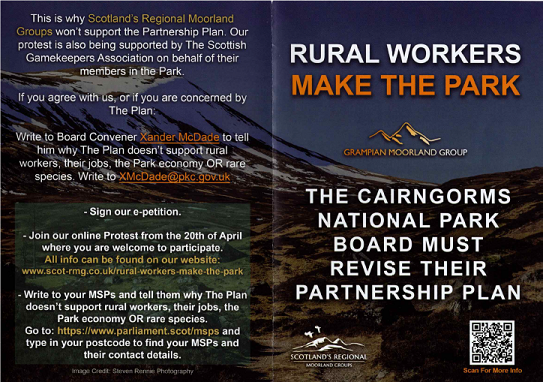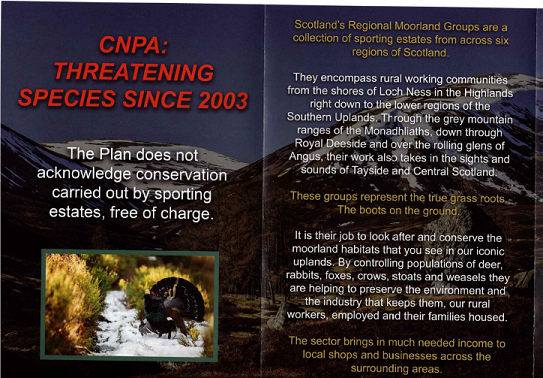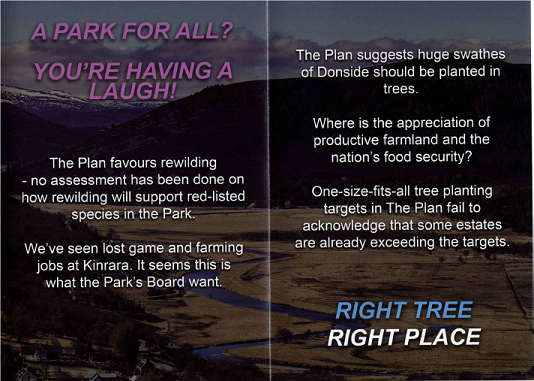 Following the online protest organised by the Grampian Moorland Group against the National Park Partnership Plan (see here), Scotland’s “Regional Moorland Groups” have been putting a glossy leaflet through the door of every household in the Cairngorms National Park. The Moorland Groups are shadowy organisations (see here) that do not declare their membership so it is not clear which sporting estates are behind the protest. The Scottish Gamekeepers Association have been far more open about their support.
Following the online protest organised by the Grampian Moorland Group against the National Park Partnership Plan (see here), Scotland’s “Regional Moorland Groups” have been putting a glossy leaflet through the door of every household in the Cairngorms National Park. The Moorland Groups are shadowy organisations (see here) that do not declare their membership so it is not clear which sporting estates are behind the protest. The Scottish Gamekeepers Association have been far more open about their support.
What we do know in terms of estate involvement, however, is that Prince Charles’s estate at Delnadamph hosted a visit organised by the Grampian Moorland Group on 8th April under the banner of “estates that educate” (see here). That raises the question of whether the royal estates at Delnadamph and Balmoral are members of the Grampian Group. I have written to the Balmoral Estate factor, Richard Gledson, asking him to clarify the royal estates’ relationship with the Moorland Groups and whether they support this protest which appears designed to undermine attempts in the Cairngorms to tackle the climate and nature emergencies.

On 28th April the Cairngorms National Park Authority (CNPA) responded to some of the more outrageous claims in the leaflet. There is no need to repeat the CNPA’s answers here, they are perfectly reasonable and worth reading (see here).
What is significant, however, is the CNPA responded not by addressing the sporting estate landowners directly [see qualification to this below under “postscript], but rather by issuing a news piece on “Commonly Asked Questions” and the National Park Partnership Plan (NPPP). Six out of seven of the commonly asked questions are in response some of the more outrageous claims made by the moorland groups: the impact of woodland expansion targets on agriculture and food security; will the plan threaten rare and endangered species; is the draft plan all about re-wilding; does the plan intend to eliminate all deer in the National Park; will jobs be threatened in the National Park through changes in land-management; were residents in favour of the draft plan?

Unfortunately, it is not likely that that many residents of the National Park, let alone Moorland Group activists, will read the CNPA’s responses tucked away as they are on their website. The CNPA appears to have decided to keep its head down and hope the challenge will go away instead of rising to the challenge from the sporting estates and meeting it head on
This softly softly approach towards the sporting estates clearly hasn’t worked so far. For example, despite making it clear in the NPPP that “(77%) of the Park will still be open habitat by 2045” (i.e much of it burnt grouse moor) and stating that natural regeneration would be the preferred method of woodland expansion, that hasn’t stopped the Moorland Groups claiming that the CNPA want “huge swathes of Donside to be planted in trees”. The CNPA repeating behind the scenes what it said in the NPPP is unlikely to do anything to change that. The truth is that many sporting estate owners are simply not open to reason and will say and do anything to protect their right to produce game for shooting at whatever the cost is to the natural environment.

While defending itself from some of the misrepresentations made by the Moorland Groups bout the NPPP, the CNPA has failed to tackle some of the other misleading and erroneous claims made in the leaflet, for example:
- Claim: “The Plan does not acknowledge conservation carried out by sporting estates free of charge”.
- Comment: It is true the NPPP says nothing about the conservation carried out by sporting estates, but that is because they do so little. Moreover, what they do do is almost invariably paid for by the public. For example, almost the entire cost of peatland restoration and woodland planting on private estates in the National Park has been paid for out of the public purse: the main exception that I am aware of, Wildland Ltd which has made significant contributions to the cost of peatland restoration in Glen Feshie is not primarily managed for sporting purposes but for conservation.
- Claim: “By controlling populations of deer, rabbits, foxes, crows, foxes, stoats and weasels they are helping to preserve the environment and the industry that keeps them, our rural workers, employed and their families housed”
- Comment 1: Where sporting estates properly control deer numbers and keep them low, as at Delnadamph, this is only because they are interested in grouse shooting, not deer stalking, and the environment is as a consequence burned to bits. None of the other examples of animal control do anything to preserve the natural environment, rather they are about maximising the number of game birds for shooting purposes.
- Comment 2: As for employment, it’s time the CNPA started speaking out about how sporting estate landowners exploit their staff. Recent research (see here), based on a survey of gamekeepers, found they worked up to 63 hours a week, most commonly for wages of £15k-£25k – i.e. often below the minimum wage – and lived in tied houses that offer no security. If the CNPA helped expose that scandal they might start winning over estate staff instead of driving them into the arms of their very rich employers.
Why is the CNPA on the defensive in the face of the lies from sporting estates?
The CNPA has so far been unwilling to challenge the current system of landownership in the National Park, which allows landowners to more or less do what they want with the land. The CNPA will never tackle the climate and nature emergencies so long as it remains unable to tackle the right of landowners to manage the land within the National Park for sporting purposes and instead tries to rely on persuasion. The failure to tackle landownership and the sporting estates explains the CNPA’s very modest targets for habitat restoration in the draft NPPP (see here).
While there are staff and Board Members who recognise these failings and would like to take a more radical approach, unfortunately they can’t. This is because of the influence landowning interests have over the Scottish Government, who control what our National Park Boards do with an iron fist, and the strength of sporting interests on the CNPA board.
The battle between the CNPA and Moorland Groups over the NPPP, was preceded by an internal battle on the CNPA board as evidenced by the recording (see here) of the closed session of the CNPA Board Meeting on 10th September which discussed the draft plan . This was made public after the event – I wrote asking why the session had not been held in public – and is still, to the CNPA’s credit publicly available.
What comes across in the video (after the presentations, from 27 minutes) is the vocal landowning lobby and how it dominates the Board. First Doug McAdam, former Chief Executive of Scottish Land and Estates which represents the big private landowners in Scotland, who complained about the lack of involvement of the Deer Management Groups and Game and Wildlife Conservation Trust in drawing up the plan. He went on to oppose the most progressive elements of the plan, the proposals to reduce deer density and the presumption against planting and deer fencing and in favour of natural regeneration.
Mr McAdam was followed by John Kirk, a farmer, who complained that peatland restoration, by holding back water, increases the chance of landslips: the implication, I think, is that Mr Kirk believes we should be draining peatbogs not restoring them. Then Geva Blackett, wife of the former factor of Invercauld, who worried that the proposals in the NPPP might drive red grouse to extinction – yes, really! It appears she never seen a wild red grouse rather than one farmed on a grouse moor. Finally, Deirdre Falconer, who works for the Glentruim Estate. She explicitly allied herself to the other three and fulminated against any progressive change. Together this quartet of Board Members took up almost a third of the meeting.
By contrast, the views other Board Members, even if supportive of the work done by staff and of the draft NPPP, appeared fragmented and most remained silent. Only one, Fiona McLean, appeared willing to challenge the sporting estate narrative, when she stated in her view the targets in the plan were not ambitious enough. However former convener, Peter Argyle, in the course of supporting the draft plan did put his finger on the root of the problem when he said that the Board needed to discuss land-ownership.
The wishy washy response from the rest of the board to the sporting quartet left the Chief Executive, Grant Moir, to defend the plan. To his credit he did that most professionally. But without a strong group of conservationists on the board prepared to challenge sporting interests, his ability and that of his staff to propose more radical action is really quite restricted.
What needs to happen
The objections made in the Moorland Group leaflet to the NPPP bear an uncanny resemblance to those made by the sporting quartet of board members six months ago. This begs the question about what links those members have with the Moorland Groups (nothing is declared under their register of interests) and what discussions they may have had since the meeting with the sporting estate owners who are behind the campaign?
The positive thing about the Moorland Groups leaflet is that it may help flush out how landowning interests are trying to undermine the CNPA, from both within the board and without, and working to prevent the National Park from achieving its statutory objectives. Exposing this would be facilitated by greater transparency, both in respect to board member interests, and if in future recordings of all board meetings were published on the web so the public could see what Board Members are saying.
Deirdre Falconer, Geva Blackett and John Kirk are all directly elected by Park residents onto the Board. Whether they would be re-elected if their constituents, many of whom are very concerned about how sporting estates manage the land, were fully aware of their view is a moot question. I am not questioning the right of local people to elect whom they so decide – democracy is very important – but to work it depends on people being properly informed (hence why the CNPA should be doing more to counter the misinformation being issued by sporting estates).
As for Doug McAdam, a government appointment, if Lorna Slater the Minister for National Parks wants to retain such a forceful voice for landowning interests on the Boards – and there is an argument for that – she has a duty to balance that with people who are prepared to advocate what is necessary to tackle the nature and climate emergencies.
[Post script. My apologies, in checking the CNPA website I somehow missed the fact that they had issued a news release titled “Statement in response to online Park Plan protest by moorland groups” on 20th April (see here). My claim, therefore that the CNPA had done nothing publicly to respond to the Moorland Groups protest was therefore wrong. However, almost none of the content of the news release addresses issues the raised by the Moorland Groups, being a description of the National Park Partnership Plan consultation process, and they there is a short paragraph about the plans to red deer numbers which is also very descriptive and does not attempt to challenge the arguments of the Moorland Groups. I believe, therefore, that my more general point that the CNPA has so far failed to take on the sport shooting interests stands.]
They are offensive to every characteristic of a real national park
Having the CNPA packed with representatives of the sporting lobby is bad enough. But last year the Scottish Government’s Environment and Forestry Directorate weighted the selection process for the NatureScot Board to favour the same reactionary interests and exclude candidates with strong environmental and conservation expertise. Why did this happen? Can Lorna Slater get a grip, or will she become a prisoner of her officials, like her predecessor?
Graeme, can you post a link to this change to selection process please? I am becoming increasingly concerned at the possibility that civil servants are actively thwarting the scottish government by giving dodgy advice, either because of lack of competence, or worse. see ferries, for example: https://www.thenational.scot/news/20041029.calmac-disaster-area-leads-experts-propose-new-ways-forward/
What comes to me as underlying the wildly inaccurate and extreme claims is a sense of panic. For the fist time the landowning fraternity sense a real challenge to their monopoly of power and indeed their culture. Much is made of the threat to jobs and local employment but what is striking as ever with sporting estates is, given the huge area of land the cover, how little employment they produce. As pointed out by Nick the wages are poor and gamekeepers and stalkers are actually heavily dependent on tips from clients. Many of the claims in the leaflet are almost farcical. For instance that that the park plan pushes and agenda that residents haven’t bought into. The average estate owner and staff would not have a clue what local residents think on that agenda